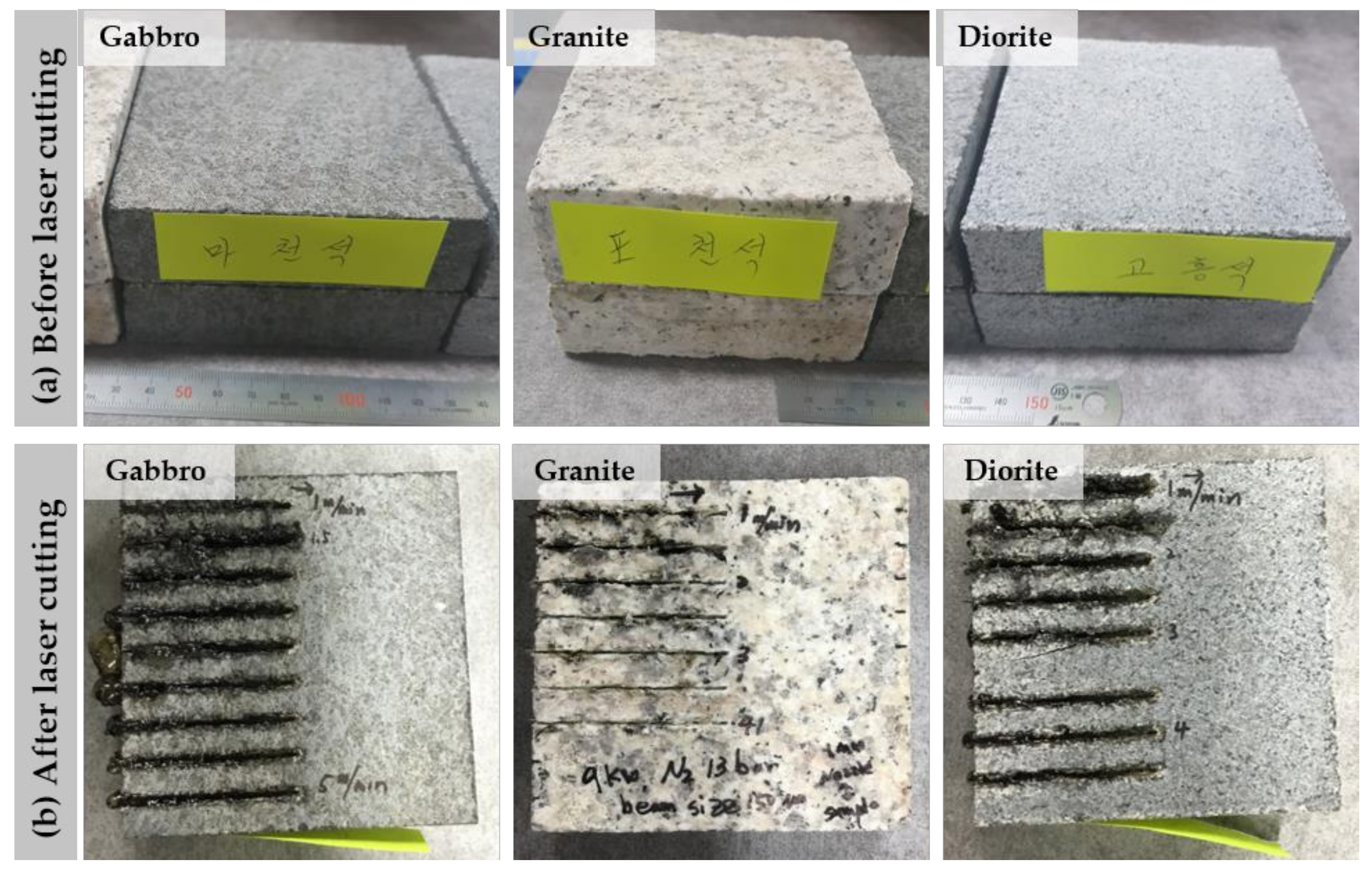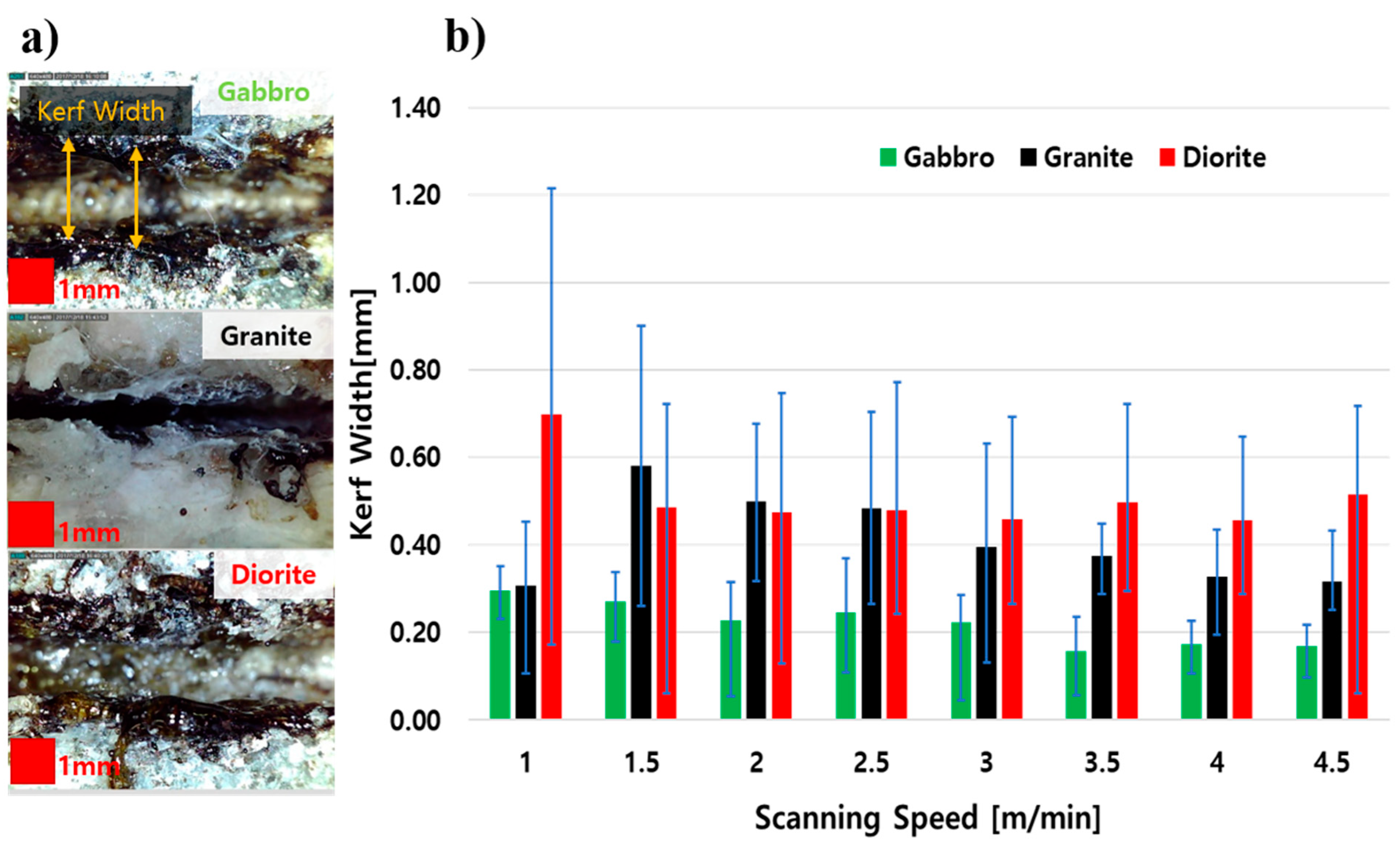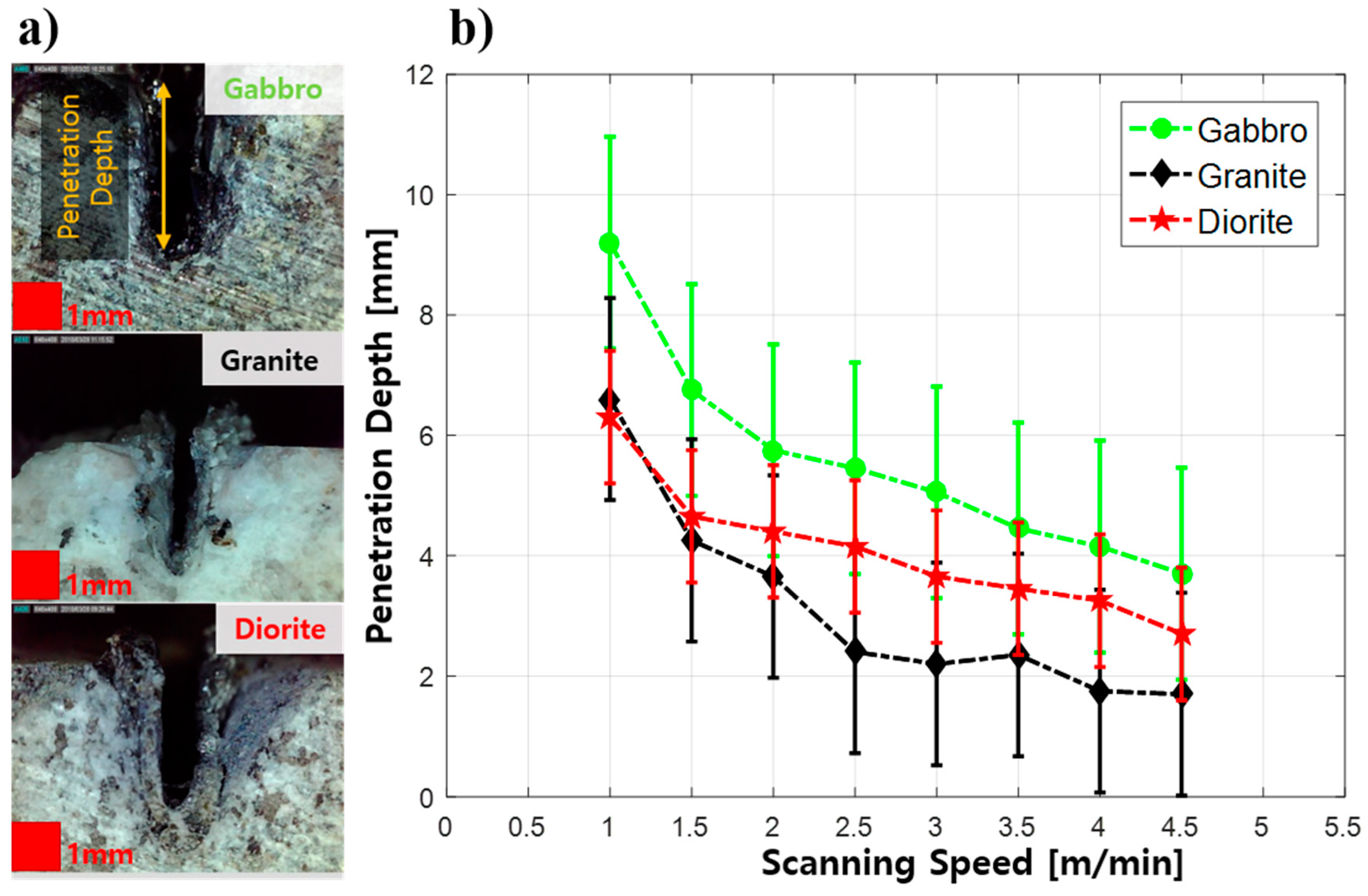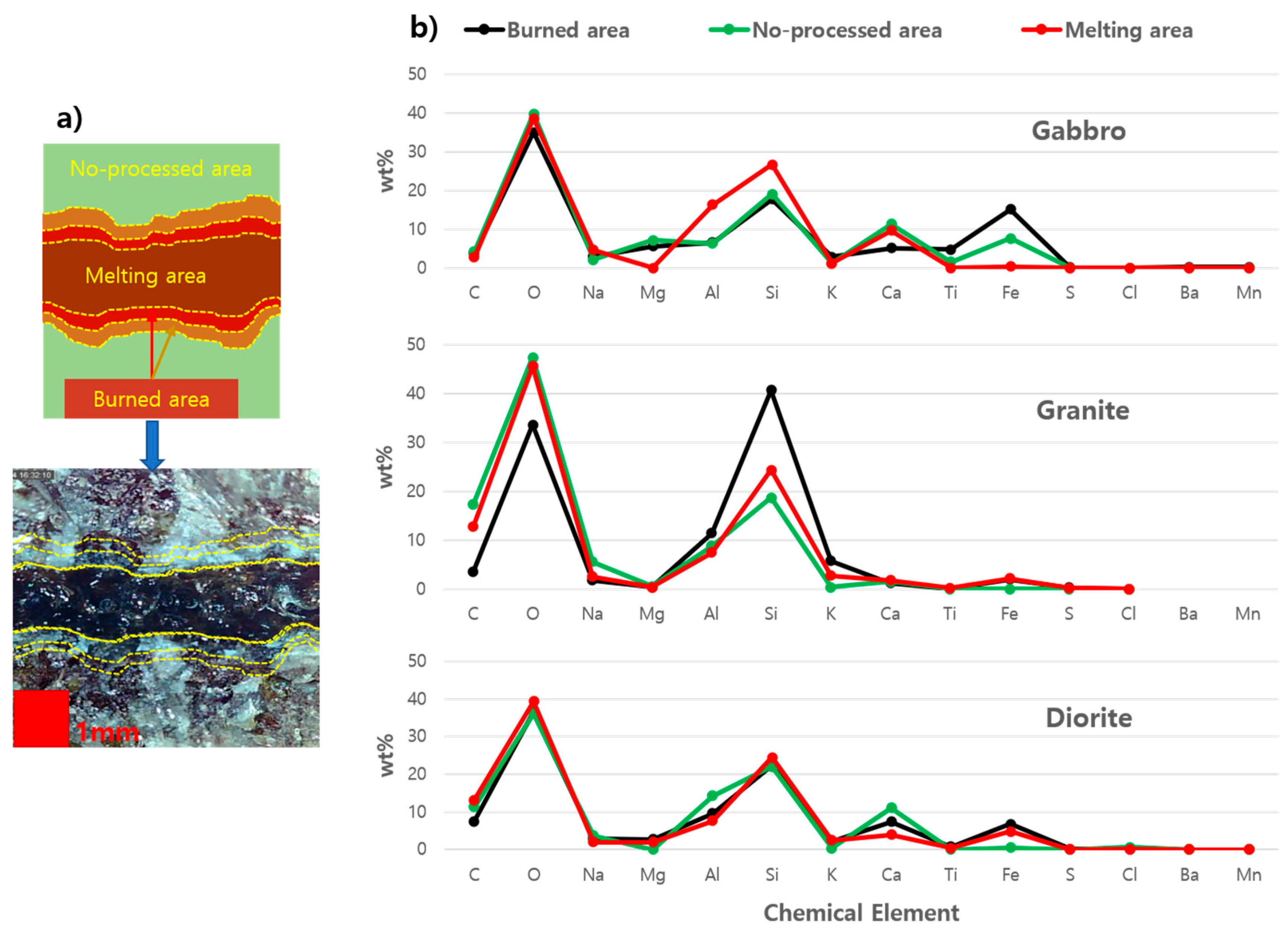An Experimental Investigation on the Cutting Quality of Three Different Rock Specimens Using High Power Multimode Fiber Laser
Abstract
1. Introduction
2. Materials and Methods
3. Results and Discussion
3.1. Kerf Width
3.2. Penetration Depth
3.3. EDX Analysis
4. Conclusions
Author Contributions
Funding
Institutional Review Board Statement
Informed Consent Statement
Data Availability Statement
Conflicts of Interest
References
- Whalen, J.B.; Currie, K.L.; Chappell, B.W. A-type granites: Geochemical characteristics, discrimination and petrogenesis. Contrib. Mineral. Petrol. 1987, 95, 407–419. [Google Scholar] [CrossRef]
- Eby, N. A-Type Granites: Characteristics, Petrogenesis and their Contribution to the Growth of the Continental Crust. The A-Type Granitoids Characteristics of A-Type Granitoids. Available online: https://faculty.uml.edu/Nelson_Eby/Research/A-type%20granites/Hutton%20A-type%20Granites.pdf (accessed on 14 July 2011).
- Verma, S.P.; Rivera-Gomez, M.A.; Diaz-Gonzales, L.; Verma, S.K.; Pandarinath, K.; Ruiz, A.-Q. Multidimensional classification of magma types for altered igneous rocks and application to their tectonomagmatic discrimination and igneous provenance of siliciclastic sediments. Lithos 2017, 278–281, 321–330. [Google Scholar] [CrossRef]
- Grout, F.F. Internal Structure of Igneous Rocks: Their Significance and Origin; With Special Reference to the Duluth Gabbro. pp. 439–458. Available online: https://www.journals.uchicago.edu/doi/pdfplus/10.1086/622605 (accessed on 5 September 2020).
- Feely, K.C.; Christensen, P.R. Quantitative compositional analysis using thermal emission spectroscopy: Application to igneous and metamorphic rocks. J. Geophys. Res. Space Phys. 1999, 104, 24195–24210. [Google Scholar] [CrossRef]
- Albar, M.H.; Osman, M.H.; Abdullah, M.S.; Ismail, B.N. Classification of Intrusive Igneous Rocks Using Digital Image Processing: A Binary Approach. J. Eng. Sci. 2013, 9, 11–19. [Google Scholar]
- Joseph, S.; Ujir, H.; Hipiny, I. Unsupervised classification of intrusive igneous rock thin section images using edge detection and colour analysis. arXiv 2017, arXiv:1710.00189. [Google Scholar]
- Kamei, A.; Owada, M.; Nagao, T.; Shiraki, K. High-Mg diorites derived from sanukitic HMA magmas, Kyushu Island, southwest Japan arc: Evidence from clinopyroxene and whole rock compositions. Lithos 2004, 75, 359–371. [Google Scholar] [CrossRef]
- Zhang, X.; Xia, Y.; Tan, Q.; Wu, D. Comparison Study on the Rock Cutting Characteristics of Disc Cutter under Free-face-assisted and Conventional Cutting Methods. KSCE J. Civ. Eng. 2018, 22, 4155–4162. [Google Scholar] [CrossRef]
- Liu, S.; Liu, Z.; Cui, X.; Jiang, H. Rock breaking of conical cutter with assistance of front and rear water jet. Tunn. Undergr. Space Technol. 2014, 42, 78–86. [Google Scholar] [CrossRef]
- Hood, M.; Alehossein, H. A development in rock cutting technology. Int. J. Rock Mech. Min. Sci. 2000, 37, 297–305. [Google Scholar] [CrossRef]
- Hignett, H.J. Rock Cutting Tools. United States Patent US4986687A, 22 January 1991. [Google Scholar]
- Seo, Y.; Pyo, S.; Lee, D. Experimental Study of Multimode Fiber Laser Cutting on Cementitious Composites. Trans. Korean Soc. Mech. Eng. A 2020, 44, 561–567. [Google Scholar] [CrossRef]
- Lee, D.; Pyo, S. Experimental Investigation of Multi-mode Fiber Laser Cutting of Cement Mortar. Materials 2018, 11, 278. [Google Scholar] [CrossRef] [PubMed]
- Seo, Y.; Lee, D.; Pyo, S. Microstructural Characteristics of Cement-Based Materials Fabricated Using Multi-Mode Fiber Laser. Materials 2020, 13, 546. [Google Scholar] [CrossRef]
- Ditmire, T.; Bless, S.; Dyer, G.; Edens, A.; Grigsby, W.; Hays, G.; Madison, K.; Maltsev, A.; Colvin, J.; Edwards, M.; et al. Overview of future directions in high energy-density and high-field science using ultra-intense lasers. Radiat. Phys. Chem. 2004, 70, 535–552. [Google Scholar] [CrossRef]
- Nishida, T.; Miyoshi, K.; Amano, Y.F. Laser Perforation Device and Laser Perforation Method. United States Patent 8,394,085, 12 March 2013. [Google Scholar]
- Kariminezhad, H.; Amani, H.; Moosapoor, M. A laboratory study about laser perforation of concrete for application in oil and gas wells. J. Nat. Gas Sci. Eng. 2016, 32, 566–573. [Google Scholar] [CrossRef]
- Xu, Z.; Reed, C.B.; Graves, R.; Parker, R. Rock perforation by pulsed Nd:YAG laser. In Proceedings of the ICALEO 2004 23rd International Congress on Applications of Laser & Electro-Optics, San Francisco, CA, USA, 4–7 October 2004. [Google Scholar]
- Carstens, J.P.; Brown, C.O. Rock cutting by laser. Presented at the Fall Meeting of the Society of Petroleum Engineers of AIME, New Orleans, Louisiana, 3–6 October 1971. [Google Scholar]
- Jurewicz, B. Rock excavation with laser assistance. Int. J. Rock Mech. Min. Sci. Géoméch. Abstr. 1976, 13, A107. [Google Scholar] [CrossRef]
- Kosyrev, F.K.; Rodin, A.V. Laser destruction and treatment of rocks. In Proceedings of the SPIE 4762, ALT’01 International Conference on Advanced Laser Technologies, Constanta, Romania, 9 August 2002; pp. 166–171. [Google Scholar] [CrossRef]
- Riveiro, A.; Mejías, A.; Soto, R.; Quintero, F.; Del Val, J.; Boutinguiza, M.; Lusquiños, F.; Pardo, J.; Pou, J. CO2 laser cutting of natural granite. Opt. Laser Technol. 2016, 76, 19–28. [Google Scholar] [CrossRef]
- Klein, C.; Carmichael, R.S. Rock. Encyclopedia Britannica. 7 May 2021. Available online: https://www.britannica.com/science/rock-geology (accessed on 13 May 2021).
- Landgren, M.; Jönsson, B. Determination of the optical properties of Si/SiO2 surfaces by means of ellipsometry, using different ambient media. J. Phys. Chem. 1993, 97, 1656–1660. [Google Scholar] [CrossRef]
- Holmberg, P. Laser Processing of Silica Based Glass; Royal Institute of Technology: Stockholm, Sweden, 2015. [Google Scholar]
- Tacail, T.; Télouk, P.; Balter, V. Precise analysis of calcium stable isotope variations in biological apatites using laser ablation MC-ICPMS. J. Anal. At. Spectrom. 2016, 31, 152–162. [Google Scholar] [CrossRef]
- Yin, H.; Yang, X.; Lu, H. A new bayesian method for reliability assessment of products with Wiener process degradation. J. Tongji Univ. 2015, 43, 1234–1238. [Google Scholar]





| Rock Type | Linear Expansion Coefficient (×10−6 per Degree Celsius) | Compressive Strength (at Room Temperature and Pressure in MPa) |
|---|---|---|
| Gabbro | 8 ± 3 | 223.5 |
| Granite | 5.4 ± 1 | 250 |
| Diorite | 7 ± 2 | 156.5 |
| Rock Type | Laser Power [kW] | Wavelength [nm] | Working Distance [mm] | N2 Pressure [bar] | Scanning Speed [mm/s] | Intensity [×107 W/cm2] | Line Energy [×1013 J/m3] |
|---|---|---|---|---|---|---|---|
| Gabbro | 9 | 1070 | 1 | 13 | 1 | 5.093 | 3.056 |
| 1.5 | 5.093 | 2.037 | |||||
| 2 | 5.093 | 1.528 | |||||
| Granite | |||||||
| 2.5 | 5.093 | 1.222 | |||||
| 3 | 5.093 | 1.019 | |||||
| 3.5 | 5.093 | 8.731 | |||||
| Diorite | |||||||
| 4 | 5.093 | 7.639 | |||||
| 4.5 | 5.093 | 6.791 |
| Descriptive | |||||||
|---|---|---|---|---|---|---|---|
| Groups | Count | Sum | Average | Variance | Standard Deviation | 95% Confidence Interval Mean | |
| Lower Bound | Upper Bound | ||||||
| Gabbro | 8 | 3.278 | 0.4097222 | 0.00998792 | 0.035333976 | 0.374388246 | 0.445056198 |
| Granite | 8 | 1.758 | 0.2197222 | 0.00248668 | 0.017630529 | 0.202091694 | 0.237352751 |
| Diorite | 8 | 4.059 | 0.5074028 | 0.00626286 | 0.027979592 | 0.479423185 | 0.53538237 |
| ANOVA | |||||||
| Source of Variation | Sum of Square | Degree of Freedom | Mean Square | F (statistic) | P-Value | F (critical) | |
| Between Groups | 0.342404248 | 2 | 0.171202124 | 27.41066638 | 0.000001398 | 3.466800112 | |
| Within Groups | 0.131162247 | 21 | 0.006245821 | ||||
| Total | 0.473566718 | 23 | |||||
| Descriptive | |||||||
|---|---|---|---|---|---|---|---|
| Groups | Count | Sum | Average | Variance | Standard Deviation | 95% Confidence Interval Mean | |
| Lower Bound | Upper Bound | ||||||
| Gabbro | 8 | 44.5 | 5.5625 | 3.09339286 | 0.062183125 | 4.940668747 | 6.184331253 |
| Granite | 8 | 24.85 | 3.10625 | 2.80888393 | 0.592545771 | 2.513704229 | 3.698795771 |
| Diorite | 8 | 32.55 | 4.06875 | 1.21924107 | 0.390391001 | 3.678358999 | 4.459141001 |
| ANOVA | |||||||
| Source of Variation | Sum of Square | Degree of Freedom | Mean Square | F (statistic) | P-Value | F (critical) | |
| Between Groups | 24.50895833 | 2 | 12.25447917 | 5.162303632 | 0.015014243 | 3.466800112 | |
| Within Groups | 49.850625 | 21 | 2.373839286 | – | – | – | |
| Total | 74.35958333 | 23 | – | – | – | – | |
Publisher’s Note: MDPI stays neutral with regard to jurisdictional claims in published maps and institutional affiliations. |
© 2021 by the authors. Licensee MDPI, Basel, Switzerland. This article is an open access article distributed under the terms and conditions of the Creative Commons Attribution (CC BY) license (https://creativecommons.org/licenses/by/4.0/).
Share and Cite
Lian, M.-M.; Seo, Y.; Lee, D. An Experimental Investigation on the Cutting Quality of Three Different Rock Specimens Using High Power Multimode Fiber Laser. Materials 2021, 14, 2972. https://doi.org/10.3390/ma14112972
Lian M-M, Seo Y, Lee D. An Experimental Investigation on the Cutting Quality of Three Different Rock Specimens Using High Power Multimode Fiber Laser. Materials. 2021; 14(11):2972. https://doi.org/10.3390/ma14112972
Chicago/Turabian StyleLian, Mang-Muan, Youngjin Seo, and Dongkyoung Lee. 2021. "An Experimental Investigation on the Cutting Quality of Three Different Rock Specimens Using High Power Multimode Fiber Laser" Materials 14, no. 11: 2972. https://doi.org/10.3390/ma14112972
APA StyleLian, M.-M., Seo, Y., & Lee, D. (2021). An Experimental Investigation on the Cutting Quality of Three Different Rock Specimens Using High Power Multimode Fiber Laser. Materials, 14(11), 2972. https://doi.org/10.3390/ma14112972







